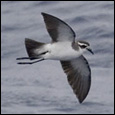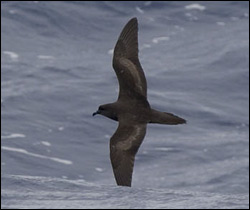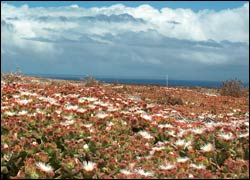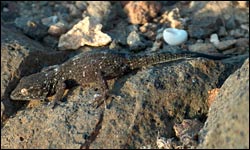
 |
| Bulwer's
Petrel off Salvage Islands. Photo: Göran Ekström |
The Selvagens may not hold a rich diversity of fauna, but there are large and very important numbers of some species of seabirds. At least 9 bird species breed regularly on the islands. All are seabirds, apart from one landbird: Berthelot's Pipit (which occurs in the Canarian form A. b. berthelotii, rather than in the Madeiran subspecies, A. b. madeirensis). Kestrel has bred in the past, and even produced a pair of albino juveniles, but has not been proved to have done so for at least 10 years. There is a single record of a Sooty Tern, breeding on Selvagem Pequena. Recently adults have been observed, but no breeding confirmed. Swinhoe's Storm-petrel is another probable breeder with birds with vascular brood patches having been captured. The seabird numbers are spectacular, however, with the following approximate numbers of pairs breeding annually: Cory's Shearwater 14-15,000, Little Shearwater (of the form baroli) 2,000, Bulwer's Petrel 5,000+, White-faced Storm-petrel 60,000, Madeiran Storm-petrel 1,500, Atlantic Yellow-legged Gull 30 and Roseate Tern 15. In addition, Common Tern also breeds on the Selvagens (in unknown numbers), while Sooty Tern has bred once.
About 26,000 pairs of White-faced Storm-petrel breed on Selvagem Grande, while a total of 31,000 pairs of this species breed on Selvagem Pequena and Ilhéu de Fora. They dig their burrows in the sandy soil, with the entrances hidden in the vegetation, and only arrive at their nests at night. The Selvagens form (Pelagodroma marina hypoleuca) differs slightly from the Cape Verde form (P. m. eadesi) in that the latter is said to have a whiter forehead (which contrasts more with the crown), a paler grey back, more white on the sides of the neck (sometimes forming an almost complete white collar), and a longer bill.
 |
| White-faced Storm-petrels, of which the right bird landed on the boat at night. Photos: Bosse Carlsson, 2005 |
The estimated 14-15,000 pairs of Cory's Shearwaters breeding on the Selvagens represent one of the largest colonies of this species (here C. d. borealis) in the world, even though the colony has been recovering very slowly since the 1976 massacre (see the "Bird Protection" section). The total population for the archipelago is more than this, as there may be an additional 30,000 non-breeding birds also present. The juveniles migrate to Brazil and only return after the age of five years as pre-breeders. Breeding usually only starts after the age of seven years, but many start much later. Interestingly, breeding Cory's Shearwaters on the Selvagens visit their nests by day as well as by night, unlike other populations in the Macaronesian Islands. The majority breed on the cliffs of Selvagem Grande. In September, the pre-breeders migrate to their wintering grounds off South America, the adults which are feeding off the African coast visit their chicks (then weighing about one and a half times as much as themselves) in the nest with diminishing frequency. Only when the young have lost weight in late October and the first week of November are they able to fly off to the South Atlantic.
 |
| An adult Cory's Shearwater on nest and a chick (right), Selvagem Grande. Photos: Isabel Fagundes |
Yellow-legged Gulls have recently become established on the archipelago in significant numbers. They predate many of the other seabirds (even at night by moonlight) and, to protect the other species, the wardens control their numbers by collecting their eggs.
Records
of vagrant species
A considerable variety of vagrant species has been recorded in the archipelago.
These include: Swinhoe's Storm-petrel, Gannet, Red-billed Tropicbird,
Cattle Egret, Night Heron, Squacco Heron, Purple Heron, Eleonora's Falcon,
Peregrine Falcon, Gyrfalcon, Curlew Sandpiper, Curlew, Whimbrel, Turnstone,
Black-headed Gull, Rock Dove, Wood Pigeon, Turtle Dove, Long-eared Owl,
Short-eared Owl, Common Swift, Plain Swift, European Bee-eater, Sand Martin,
Swallow, Red-rumped Swallow, House Martin, Tawny Pipit, Tree Pipit, White
Wagtail, Grey Wagtail, Robin, Common Redstart, Black Redstart, Wheatear,
Mistle Trush, Grasshopper Warbler, Rüppell's Warbler, Spectacled
Warbler, Subalpine Warbler, Icterine Warbler, Melodious Warbler, Western
Bonelli's Warbler, Spotted Flycatcher, Semi-collared Flycatcher and Woodchat
Shrike.
 |
| From left: Sooty
Tern, Eleonora's Falcon and Icterine Warbler. All seen at Selvagem
Pequena in 2005. Photos: Göran Ekström (July) and Ole Krogh (the Icterine Warbler, September) |
 |
| Flowering Ice
Plants on Selvagem Grande. Photo: João Nunes |
The scientific and natural history interest in this tiny group of islands lies not only in its seabirds, but also in its unique flora (as well as its marine biodiversity). The Selvagens host ca. 100 species of plants, most of which are small and stunted. The richest islands for flora are Selvagem Pequena and Ilhéu de Fora, because these have not suffered from the introduction of non-indigenous animals or plants (which have somewhat damaged the floral diversity on Selvagem Grande). Eleven of these are endemic to the Selvagens (9 on Selvagem Pequena and Ilhéu de Fora), for example: Shrubby Chrysanthemum Argyranthemum thalassophilum, Shrubby Spurge Euphorbia obtusifolia var. desfoliata (only on Ilhéu de Fora, and with its own endemic wingless beetle), Salvage Islands Snapdragon Misopates salvagense and Lowe's Stonecrop Monanthes lowei. The Ice Plant Mesembryanthemum crystallinum and Egyptian Fig-Marigold Mesembryanthemum nodiflorum are fixers of the soil on the islands' sandy plateaux, and important for those seabirds (especially the White-faced Storm-petrel) that dig their nest holes in this habitat.
 |
| The
endemic Selvagens Gecko. Photo: João Nunes |
Two species of reptile occur on the Selvagens: Madeiran Wall Lizard, (Podarcis dugesii) is present on Selvagem Grande and Selvagem Pequena, while Selvagens Gecko (Tarentola bischoffi), which can be found on Selvagem Grande only, has recently been accepted as an endemic species to the Selvagens.
Cetaceans
and sea turtles
Whales are
not regularly seen in these waters, in comparision to the waters around
Madeira and Desertas, but there is good chances to spot schools of different
dolphin species, most likely Bottlenose and Atlantic Spotted Dolphins.
The most frequently sea turtle recorded in these waters are Loggerhead
Turtle (Caretta caretta).
Copyright © 2005-2008, All rights reserved